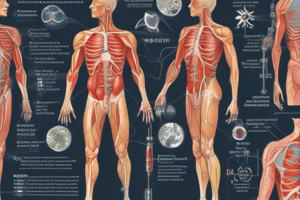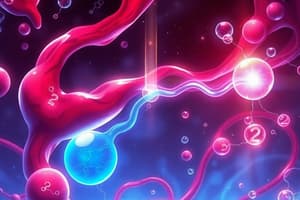Podcast
Questions and Answers
What is the primary function of buffers in the body?
What is the primary function of buffers in the body?
- To maintain a constant temperature.
- To increase the rate of respiration.
- To release H+ ions in solution.
- To convert strong acids or bases into weak ones. (correct)
Which buffer system is considered the first line of defense against pH changes in the body?
Which buffer system is considered the first line of defense against pH changes in the body?
- Renal buffer system
- Phosphate buffer system
- Respiratory buffer system
- Bicarbonate buffer system (correct)
Which of the following conditions results from an excess of carbonic acid in the body?
Which of the following conditions results from an excess of carbonic acid in the body?
- Alkalosis
- Hydration
- Acidosis (correct)
- Homeostasis
What role do physiological buffers play in pH regulation?
What role do physiological buffers play in pH regulation?
What is the normal pH range that the body maintains?
What is the normal pH range that the body maintains?
What percentage of the body’s water is found in intercellular fluid?
What percentage of the body’s water is found in intercellular fluid?
Which mechanism primarily stimulates thirst when the total body water declines?
Which mechanism primarily stimulates thirst when the total body water declines?
What is the primary outcome when the concentration of electrolytes in tissue fluid rises?
What is the primary outcome when the concentration of electrolytes in tissue fluid rises?
Which type of disorder involves an imbalance resulting in excessive water retention in the body?
Which type of disorder involves an imbalance resulting in excessive water retention in the body?
What role does ADH (antidiuretic hormone) play when body water is low?
What role does ADH (antidiuretic hormone) play when body water is low?
What is the primary regulatory hormone that adjusts sodium excretion?
What is the primary regulatory hormone that adjusts sodium excretion?
Which electrolyte imbalance is considered a medical emergency due to its potential to cause cardiac arrhythmias?
Which electrolyte imbalance is considered a medical emergency due to its potential to cause cardiac arrhythmias?
What is the normal plasma level range for phosphate in mg/dL?
What is the normal plasma level range for phosphate in mg/dL?
Which of the following is NOT a function of calcium in the body?
Which of the following is NOT a function of calcium in the body?
What primarily determines the pH of a solution?
What primarily determines the pH of a solution?
What condition results from losing more water than sodium and can lead to hypovolemic shock?
What condition results from losing more water than sodium and can lead to hypovolemic shock?
Which of the following best describes the condition of fluid excess occurring with renal failure?
Which of the following best describes the condition of fluid excess occurring with renal failure?
Which electrolyte has a normal plasma range of 3.5 to 5.3 mEq/L?
Which electrolyte has a normal plasma range of 3.5 to 5.3 mEq/L?
Fluid accumulation in interstitial spaces is referred to as what condition?
Fluid accumulation in interstitial spaces is referred to as what condition?
What is the main characteristic of dehydration compared to volume depletion?
What is the main characteristic of dehydration compared to volume depletion?
Flashcards are hidden until you start studying
Study Notes
Buffers
- Buffers resist changes in pH by converting strong acids or bases into weak ones
- Two categories: chemical buffers and physiological buffers
- Chemical buffers include: bicarbonate buffer system, phosphate buffer system, and protein buffer system
- Physiological buffers use the respiratory and urinary systems to alter the output of acids, bases, or CO2.
- Not all buffer systems begin working at the same time. The order is: chemical buffers, respiratory system, then renal system.
- Maintaining the body's pH range of 7.35 to 7.45 depends on a precise ratio of bicarbonate ions to carbonic acid
- An excess of carbonic acid causes acidosis
- An excess of bicarbonate causes alkalosis
Fluid Compartments
- Intercellular fluid (ICF) - Most of the body's water (about 65%) resides inside the cells
- Extracellular fluid (ECF) - 35% of body's water is outside the cells
- Interstitial Fluid - Extracellular fluid includes the fluid between the cells inside tissue
- ICF and ECF continually mingle
- If the concentration of electrolytes of tissue fluid rises, water moves out of the cells and into the tissue
- If the osmolarity of tissue fluid falls, water moves out of the tissue and into the cells
Balancing Water Gain and Loss
- Normally the amount of water gained and lost by the body through the course of the day is equal
- An adult gains and loses about 2500 mL of fluid each day
- Most fluid intake occurs through eating and drinking
- Cells produce water as a byproduct of metabolic reactions (Metabolic water)
- Fluid is lost through the kidneys as urine, the intestines as feces, the skin by sweat and diffusion, and the lungs through expired air
Regulation of Intake and Output
- The body uses mechanisms that adjust fluid intake as well as urine output
- When total body water declines, physical changes stimulate the thirst center in the hypothalamus, salivation decreases causing dry mouth and thirst, and water consumption occurs
- To decrease urine output: physical changes stimulate the hypothalamus, ADH prompts the collecting ducts of the kidneys to reabsorb more water and produce less urine
- The rate of fluid loss slows until water is ingested
Disorders of Water Balance
- Three types of disorders: fluid deficiency, fluid excess, and fluid accumulation
- Fluid deficiency results when output exceeds intake
- Two types of fluid deficiency: volume depletion (blood loss or loss of fluids like diarrhea) and dehydration (losing more water than sodium)
- Dehydration can lead to hypovolemic shock
- Fluid excess occurs when fluid intake exceeds output.
- The kidneys usually compensate for excess fluid, but renal failure is one cause of fluid excess
- Fluid excess can manifest in: water intoxication (consuming excessive amounts of water or replacing water losses with only water) and fluid excess (ECF remains isotonic) - retention of both sodium and water
- Fluid accumulation leads to edema (fluid accumulates in interstitial spaces)
- Fluid can accumulate in organs and tissues of the body (commonly lungs and brain)
Electrolyte Balance
- Electrolytes are substances that dissociate into ions in water
- Electrolyte levels are measured in plasma
- Electrolyte Levels (plasma):
| Electrolyte | Range (mEq/L) |
|---|---|
| Sodium | 135 to 145 |
| Potassium | 3.5 to 5.3 |
| Calcium | 8.2 to 10.2 |
Chloride
- Most abundant extracellular anion
Phosphate
- Plasma level: 2.5 to 4.5 mg/dL
Sodium
- Main electrolyte in extracellular fluid, also the chief cation.
- Sodium levels are primarily regulated by aldosterone and ADH.
- Aldosterone adjusts sodium excretion
- ADH adjusts water excretion
Potassium
- Chief cation of intracellular fluid
- Works hand-in-hand with sodium
- Potassium imbalances are the most dangerous of any electrolyte imbalance, very high levels considered a medical emergency
- Imbalances can cause life-threatening cardiac arrhythmias
Calcium
- Functions: strengthening bones, muscle contraction, nerve transmission, blood clotting
- Plasma calcium levels are regulated by parathyroid hormone
Chloride and Phosphate
- Chloride is the most abundant extracellular anion.
Acid-Base Balance
- One of the most important factors influencing homeostasis is the body's balance between acids and bases.
Acids and Bases
- The pH of a solution is determined by its concentration of hydrogen (H+) ions.
Studying That Suits You
Use AI to generate personalized quizzes and flashcards to suit your learning preferences.




